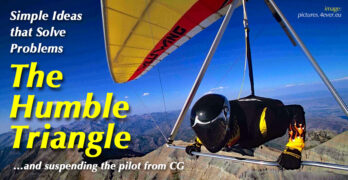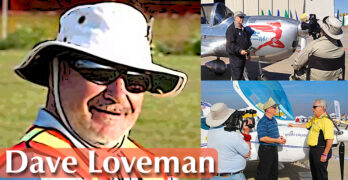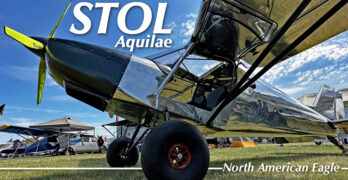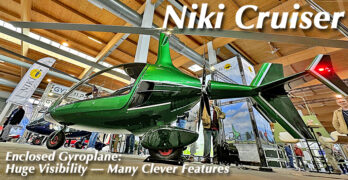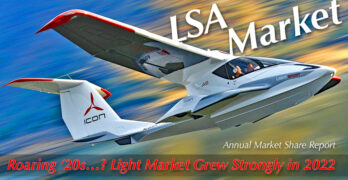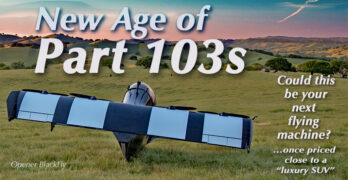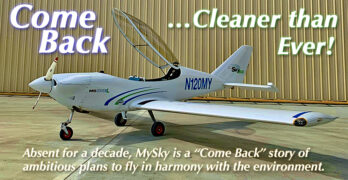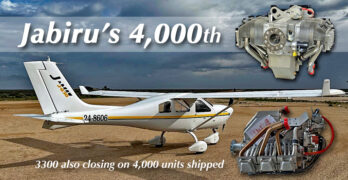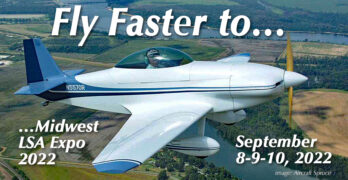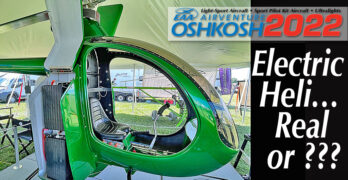When Wilbur and Orville set out to fly their first airplane 120 years ago, aeronautical knowledge was rare and precious. Pioneers like Lilienthal preceded the Wright Brothers but the Ohio bike shop owners still had to figure out almost everything. They did so without funding, university degrees, or government help. Today, nearly every aviator celebrates their December 1903 achievement.
Aviation is a many-varied activity, though, and not all aircraft followed the same development path. Especially after World War II and the arrival of kit-built aircraft, American aviators began exploring in many directions.
Around the time NASA was pushing hard to land on the moon, a growing group of enthusiasts were jumping off mountains in pursuit of flight. Hang gliding soared into sky in the late 1960s and early 1970s. Enthusiasts grew to more than 100,000 active hang glider pilots globally, flying in nearly every country on Earth, perhaps as the most affordable of all aircraft.
Search Results for : evolution
Not finding exactly what you expected? Try our advanced search option.
Select a manufacturer to go straight to all our content about that manufacturer.
Select an aircraft model to go straight to all our content about that model.
Dave Loveman: Pilot, Videographer, Engine Expert, and Aviation Leader… One Unique Individual
As you can surely tell by all the images, and by the lead picture, this story is only about airplanes in the sense that it covers one of the most productive people in light aviation. I refer to my longtime associate, Videoman Dave, as I enjoyed calling him.
At the end of October 2023, his daughter Nicole emailed me to say that Dave passed peacefully in his sleep following a two-year battle with plasma cell leukemia, a very rare form of cancer with limited treatment options. Many of you have asked about him at airshows this year and I reported what I knew. Dave was not one to complain about his situation so when we spoke, we mostly kept our conversation on airplanes.
Nonetheless, the facts became increasingly obvious. All you had to do was check his YouTube channel. At the end, more than 11 months passed since his last entry.
Latin for Eagle, Aquilae is A New Kit Entry in the STOL space from North American Eagle
Let’s get that name dealt with right away — say “ACK-will-lay.” The model name looks more awkward than it is and sounds more graceful than it looks. The word translates from Latin as Eagle. Though unusual, Aquilae is a worthy name for a light aircraft.
When you glance at the photos nearby, do you get the feeling you’ve seen this before? You should, but you may be wrong.
Popular Design Configuration
Aquilae looks very much like but is not the G1 STOL seen earlier (see this article). Some years before G1 arrived here in America, I’d written about French-produced version after seeing it equipped with hand controls and with its wings folded compactly on a trailer at the German Aero Friedrichshafen show. The basic design has been flying for close to 25 years.
Originally developed as the Yuma by Alisport, a French company, the design was later taken over by G1 Aviation, another French company that does extensive machine shop work for several aircraft builders.
Aero ’23 Continued — Superpowered Niki Aviation Cruiser Gyroplane Shows Stylish Innovation
If the bright green didn’t catch your eye, the unusual placement of the propeller probably did. Or maybe it was one of a dozen other fetching attributes to this handsome rotary-winged aircraft.
What you could not easily see was the engine selection. As up-to-date as they can be, Niki is offering either a 141-horsepower Rotax 915iS or the just-released 160-horsepower 916iS. The latter with a lighter load can reportedly climb better than 2,500 feet per minute.
As I cruised the immense (basketball gymnasium-sized) halls of Aero 2023, I saw all manner of beautiful flying machines. In four days of the show, I find it unlikely you can even visit all of them much less become well informed about a majority.
When I happened across Niki, I remembered they had sent an invitation to come by and look at their engaging designs. Company co-owner Miglena Kopcheva was kind enough to show me around the green machine you see nearby.
2022 In Review — How Did LSA and Sport Pilot Kit Aircraft Fare During a Turbulent Year?
The year started with hope. As 2022 arrived, America and most countries (China excepted) were emerging from two years of difficult lockdowns and Covid. The good news was that a flood of money from the U.S. government had buoyed the stock market and I’ve long observed that in a rising equities market, LSA and SP kit aircraft sell well.
No one thinks this is because anyone sells stock to buy a Light-Sport Aircraft. Rather, it’s something economists call the “wealth effect,” where rising asset values give stockholders confidence that good times are here and they can buy an airplane to have fun.
Then… Russia invaded Ukraine and global markets trembled.
Despite a year of war, of plunging stock markets and sky-high energy prices, of protests and riots in multiple countries, plus on-going supply chain strains and lingering Covid fears, the light aircraft nonetheless grew by a very healthy 18%, after rising 10% in 2021.
Invasion of the Part 103 Multicopters — Surveying 5 Entries, All “No Pilot License Required”
These new-millennia flying machines have inspired multiple names. While an eventual winner is determined, a common handle seems to be the rather awkward “eVTOL” — for electric vertical takeoff and landing. A range of abbreviations are also used: UAV, UAM, UAS, autonomous aircraft, and several others. I like multicopter — because all of them involved multiple propellers doing the lifting.
Most commonly, you hear “drone.”
Yet “drone” is further confusing because we haven’t separated crewed aircraft from uncrewed aircraft and this is a major distinction. FAA has also made this separation, so for this article, I will only speak of crewed aircraft, that is, a flying machine with a pilot using controls to direct its flight. In addition, I will also stick solely to single place aircraft that can theoretically qualify as a legitimate Part 103 ultralight vehicle.
Let me first extend a quick thanks to IEEE’s Spectrum magazine for making me aware of entries I’d missed.
Come Back… Cleanly! MySky Returns with Plans to Make Flying Friendlier
Once upon a time, I was able to report three or more new Special Light-Sport Aircraft every month. That was more than a decade back when the pace of new arrivals seemed faster than a rocket parachute deployment. Lots of airplane developers from all over the globe wanted a piece of this promising LSA action with its greater freedoms and breathtaking pace of innovation. New models were announced with regularity.
For the past few years that torrid pace slowed… just as it has in every other industry I’ve examined. However, in aviation it is uncommon for a good airplane to actually disappear forever. Designs worth their avgas often manage a come-back, a term meant to show a return to market for a flying machine some may have written off earlier.
Here is such a story.
MySky MS-One
From the day I laid eyes on it, I liked the tandem seating, comfortable cockpit, and sturdy construction of MySky’s MS-1 or MS-One.
Jabiru Engines Approaching 8,000 Engines Produced — Plus, Our List Reporting Every LSA Engine
When I was a kid, I was a New York Yankees baseball fan. Why? I’d never been to New York; I lived in the midwest. I loved the baseball team because they won a lot. The saying way back then was, “The American League battle isn’t to determine who wins, but which team might come in second.” Everybody knew the Yankees would win again. (As I said, this was some time back in history.)
In light aviation, we have a roughly similar situation. Rotax provides somewhere around 70-80% of all engines for aircraft in the light aircraft space globally. The remaining 20-30% is divided between Continental or Titan, Jabiru, ULPower, and a growing collection of converted auto engines (though the latter, without ASTM approval, are used only on kit aircraft or ELSAs).
US Sport Planes owner Scott Severen, who represents Jabiru in America, declared for the Australian manufacturer, “The 4,000th Jabiru 2200 four-cylinder, 81-horsepower engine [was] recently produced at the Jabiru facility.” And, he added, “The 3300 engine [series is] fast approaching this number, too.”
So, Jabiru may not be #1, but the “down-under” company achieved a significant benchmark when they shipped number 4,000 of the 2200 series.
It’s Almost Fall 2022 and It’s Time for Two Favorite Light-Sport Aircraft Aviation Events
As Labor Day approaches each year, pilots in the Midwest U.S. — and some from much further away — start heading to Mt. Vernon, Illinois. About an hour’s drive East of St. Louis, Missouri, Mt. Vernon is home to a dedicated sector show that has emerged as a favorite.
This is the 14th year for the Midwest LSA Expo, so airport manager and all-around good guy Chris Collins is starting to psyche up for his benchmark 15th year in 2023. Putting this in perspective, that’s as old as the Sebring LSA Expo ever got before it disbanded. I’ll bet Chris never really thought about running one of the most established shows in the country.
While I cannot speak for every attendee, I can tell you that vendors return year after year for a very good reason: they sell airplanes. Pilots can thoroughly examine an airplane and perhaps make their decision.
Oshkosh 2022 – Day 2… Electric Helicopter from Composite FX is Lean, Green Machine
A year ago at Oshkosh, I became intrigued by the way Composite FX had developed the older Mosquito into their XE line; multiple models running from a legitimate Part 103 helicopter, their XEL model, to the turbine XET model. The company builds these handsome aircraft in Trenton, Florida after acquiring the design from Canadian John Uptigrove (see image of his original).
Vertical takeoff has a special appeal, even to those of us with little or no rotary experience. Setting aside the skills to fly such machines, the cost of a helicopter is usually so high that many don’t even consider it. Maybe they didn’t look far enough.
Composite FX and their $60,000 ready-to-fly XEL model (kit for $47,000) completely changes that thought experiment. Not only does this handsome aircraft perform impressively in experienced hands but many can afford it.
Yet this article is not about the product line the manufacturer is presently delivering.
- « Previous Page
- 1
- 2
- 3
- 4
- 5
- …
- 21
- Next Page »


